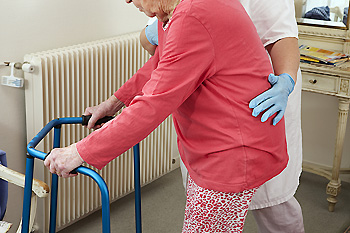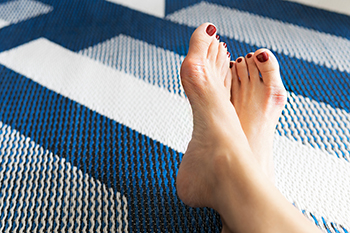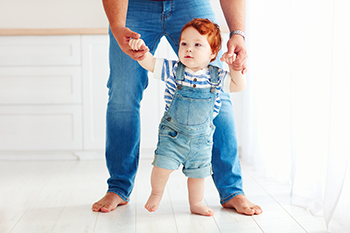Items filtered by date: April 2023
Gout and Foods

The arthritic condition known as gout often causes extreme pain. The foot ailment affects the joints in the big toe, causing redness and swelling. Gout can develop for genetic reasons or from specific types of foods that are consumed, which are laden with purines. These can include red meat, shellfish, and drinks that are made with large amounts of sugar. Excess uric acid can be produced from these foods and converted into crystals that lodge in the joints of the big toe. People generally experience a gout attack for approximately one week, but it may resurface if eating habits are not changed. Episodes of gout may be prevented by drinking plenty of fresh water and engaging in a gentle exercise program. It is also beneficial to include fresh vegetables and fruits in your diet and to limit foods that have excess purines. If you are afflicted with gout, it is strongly suggested that you confer with a podiatrist who can guide you toward management and prevention techniques.
Gout is a painful condition that can be treated. If you are seeking treatment, contact Amir Shalev, DPM from Complete Foot & Ankle Care. Our doctor will treat your foot and ankle needs.
What Is Gout?
Gout is a form of arthritis that is characterized by sudden, severe attacks of pain, redness, and tenderness in the joints. The condition usually affects the joint at the base of the big toe. A gout attack can occur at any random time, such as the middle of the night while you are asleep.
Symptoms
- Intense Joint Pain - Usually around the large joint of your big toe, and it most severe within the first four to twelve hours
- Lingering Discomfort - Joint discomfort may last from a few days to a few weeks
- Inflammation and Redness -Affected joints may become swollen, tender, warm and red
- Limited Range of Motion - May experience a decrease in joint mobility
Risk Factors
- Genetics - If family members have gout, you’re more likely to have it
- Medications - Diuretic medications can raise uric acid levels
- Gender/Age - Gout is more common in men until the age of 60. It is believed that estrogen protects women until that point
- Diet - Eating red meat and shellfish increases your risk
- Alcohol - Having more than two alcoholic drinks per day increases your risk
- Obesity - Obese people are at a higher risk for gout
Prior to visiting your podiatrist to receive treatment for gout, there are a few things you should do beforehand. If you have gout you should write down your symptoms--including when they started and how often you experience them, important medical information you may have, and any questions you may have. Writing down these three things will help your podiatrist in assessing your specific situation so that he or she may provide the best route of treatment for you.
If you have any questions, please feel free to contact our office located in Las Vegas, NV . We offer the newest diagnostic and treatment technologies for all your foot care needs.
Plantar Warts Can Be Treated!
Installations and Falls Prevention

If you are a senior citizen or are currently caring for one, then it might be important to remember that doing what you can to prevent falls can help maintain proper foot health. This is because suffering a fall can lead to foot injuries and other conditions in a senior. In order to prevent falls, you might consider the potential benefits of adding installations in the senior’s home. For example, installing certain objects around the home, such as handrails on both sides of the stairwell, can give a senior extra support when navigating the stairs. Additionally, the installation of grab bars in the shower or tub may help senior citizens support themselves and gain balance when bathing. Lastly, and importantly, you might consider installing a raised toilet seat that has armrests to provide ample stability for the senior when using the restroom. All of these installations might serve to increase the senior’s stability and decrease the likelihood of suffering from a fall. It is suggested that you contact a podiatrist today for more information about preventing falls.
Preventing falls among the elderly is very important. If you are older and have fallen or fear that you are prone to falling, consult with Amir Shalev, DPM from Complete Foot & Ankle Care. Our doctor will assess your condition and provide you with quality advice and care.
Every 11 seconds, an elderly American is being treated in an emergency room for a fall related injury. Falls are the leading cause of head and hip injuries for those 65 and older. Due to decreases in strength, balance, senses, and lack of awareness, elderly persons are very susceptible to falling. Thankfully, there are a number of things older persons can do to prevent falls.
How to Prevent Falls
Some effective methods that older persons can do to prevent falls include:
- Enrolling in strength and balance exercise program to increase balance and strength
- Periodically having your sight and hearing checked
- Discuss any medications you have with a doctor to see if it increases the risk of falling
- Clearing the house of falling hazards and installing devices like grab bars and railings
- Utilizing a walker or cane
- Wearing shoes that provide good support and cushioning
- Talking to family members about falling and increasing awareness
Falling can be a traumatic and embarrassing experience for elderly persons; this can make them less willing to leave the house, and less willing to talk to someone about their fears of falling. Doing such things, however, will increase the likelihood of tripping or losing one’s balance. Knowing the causes of falling and how to prevent them is the best way to mitigate the risk of serious injury.
If you have any questions, please feel free to contact our office located in Las Vegas, NV . We offer the newest diagnostic and treatment technologies for all your foot care needs.
Bunions Are a Deformity

Some people notice small signs that they may be developing a bunion. It may be more difficult to take long walks, and wearing high heels may prove to be painful. Bunions develop gradually, and can happen for genetic reasons or from wearing shoes that do not have adequate room in the toe area. This can cause the side of the big toe to rub against the shoe, and a small, hardened bump may form. A bunion is considered to be a deformity, and it may cause the other toes to shift toward each other. A callus or corn may form on top of the bunion, and the toe may be red and difficult to move. Temporary relief may be found when the shoes that are worn fit correctly. Some patients place a protective pad over the bunion, which may help to protect it against developing calluses. Wearing custom made orthotics may help to reduce existing discomfort, and performing specific foot exercises may prove to be beneficial in strengthening the foot. If you have developed a bunion, it is suggested that you confer with a podiatrist who can offer you additional relief solutions.
If you are suffering from bunions, contact Amir Shalev, DPM of Complete Foot & Ankle Care. Our doctor can provide the care you need to keep you pain-free and on your feet.
What Is a Bunion?
A bunion is formed of swollen tissue or an enlargement of boney growth, usually located at the base joint of the toe that connects to the foot. The swelling occurs due to the bones in the big toe shifting inward, which impacts the other toes of the foot. This causes the area around the base of the big toe to become inflamed and painful.
Why Do Bunions Form?
Genetics – Susceptibility to bunions are often hereditary
Stress on the feet – Poorly fitted and uncomfortable footwear that places stress on feet, such as heels, can worsen existing bunions
How Are Bunions Diagnosed?
Doctors often perform two tests – blood tests and x-rays – when trying to diagnose bunions, especially in the early stages of development. Blood tests help determine if the foot pain is being caused by something else, such as arthritis, while x-rays provide a clear picture of your bone structure to your doctor.
How Are Bunions Treated?
- Refrain from wearing heels or similar shoes that cause discomfort
- Select wider shoes that can provide more comfort and reduce pain
- Anti-inflammatory and pain management drugs
- Orthotics or foot inserts
- Surgery
If you have any questions, please feel free to contact our office located in Las Vegas, NV . We offer the newest diagnostic and treatment technologies for all your foot care needs.
Children’s First Shoes

Children’s feet are flexible and pliable when they are born. Each foot has 26 bones that will harden as the time for walking approaches. This generally occurs between eight and 18 months, and often parents notice their child walks with their toes inward. This usually corrects itself as the muscles, ligaments, and tendons become stronger within the foot. It is beneficial for the child to walk barefoot while indoors, and the foot can strengthen as the toes grip the floor. When it is time to walk outdoors, it is beneficial for the first pair of shoes to be made of flexible materials with a flat sole, and the feet need to be measured every few months to determine the correct shoe size. Additionally, the toes need to move freely in the chosen shoes, and laces or straps are recommended that can help to prevent excess movement. If you have questions about what type of shoes to purchase for your child’s growing feet, it is suggested that you confer with a podiatrist who can address any concerns you may have.
The health of a child’s feet is vital to their overall well-being. If you have any questions regarding foot health, contact Amir Shalev, DPM of Complete Foot & Ankle Care. Our doctor can provide the care you need to keep you pain-free and on your feet.
Tips for Keeping Children's Feet Healthy
- Make sure their shoes fit properly
- Look for any signs of in-toeing or out-toeing
- Check to see if they have Clubfoot (condition that affects your child’s foot and ankle, twisting the heel and toes inward) which is one of the most common nonmajor birth defects.
- Lightly cover your baby’s feet (Tight covers may keep your baby from moving their feet freely, and could prevent normal development)
- Allow your toddler to go shoeless (Shoes can be restricting for a young child’s foot)
- Cut toenails straight across to avoid ingrown toenails
- Keep your child’s foot clean and dry
- Cover cuts and scrapes. Wash any scratches with soap and water and cover them with a bandage until they’ve healed.
If you have any questions, please feel free to contact our office located in Las Vegas, NV . We offer the newest diagnostic and treatment technologies for all your foot care needs.

